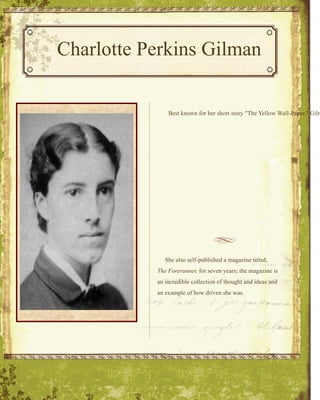
Charlotte
- 1. Newletter_1 Charlotte Perkins Gilman Stationery She also self-published a magazine titled, The Forerunner, for seven years; the magazine is an incredible collection of thought and ideas and an example of how driven she was. Best known for her short story "The Yellow Wall-Paper," Gilman was a woman who wrote a great number of works, from short journalism to book length discussions of the social realities of women's lives to poetry. Her book, Women and Economics was acclaimed as a major triumph and re-published in several languages; Vassar College even used it as a textbook for a short time. Gilman's major concern during her lifetime was feminism-- women's suffrage as well as women's economic independence.
- 2. Newletter_3 Biography She was born Charlotte Anna Perkins, on July 3, 1860, in Hartford, CT. Her mother was Mary Fitch Westcott, and her father was Frederic Beecher Perkins. This made Gilman the great granddaughter of Lyman Beecher, and the great-niece of Henry Ward Beecher and Harriet Beecher Stowe. She had a brother, Thomas Adie, who was 14 months older; there were two siblings who died in infancy. Gilman's mother was advised to have no more children, soon after this, her father left the family on their own. Critics have guessed that the basis for his desertion was concern of killing his wife in childbirth. (Wells) The family was sent to live with relatives; they were the "poor relations" who traveled around frequently during Gilman's childhood. Maybe this is one reason that Gilman herself developed unsure outlook about marriage and declared to not marry. Needless to say, that vow was broken when she married Charles Walter Stetson. Their marriage was a troubled one, eventually ending in a controversial divorce. They had one daughter, Katherine Beecher Stetson who was born March 23, 1885. Many years later (in 1900), Gilman was re-married to her cousin George Houghton Gilman; they remained happily married until his sudden death May 4, 1934. After his death, Gilman moved to California to be with her daughter and her family. Gilman learned in 1932 that she had incurable breast cancer. As an advocate for the right-to-die, Gilman committed suicide on August 17, 1935 by taking an overdose of chloroform. She "chose chloroform over cancer" as her autobiography and suicide note stated. (Wells) It seems that in her lifetime, Gilman was well respected among her peers and socialist circles. Her original attempt at publishing “ The Yellow Wallpaper ” failed as Horace Scudder, the editor of The Atlantic wrote, “ that it was so terribly good that it ought never to be printed. ” (Reuben)
- 4. Newletter_3 Prior to the twentieth century, men delegated and defined women’s responsibilities. Although all women were affected by men shaping women’s behavior, for the most part middle class women suffered. Men carried out an ideological prison that subjected and suppressed women. There were three main feminist movements in the late 1800’s through the early 1900’s. After 1870, “the suffragists” focused on winning for women the right to vote. Their opinions were slightly different than those of suffragists before the Civil War . Early reformers had argued that women, as human-beings, had a natural right to vote. From the 1870s on, however, suffragists took their cues from the Cult of True Womanhood and contended that women were unlike and, in some cases, better than men. Women, for example, were more noble, more spiritual, and truer of heart then men. Granting women the right to vote, they argued, would help filter political corruption in the United States. Social feminists agreed with the suffragists that women should get the vote, but dedicated themselves to social reforms other than suffrage. Part of that generation of women who first gained access to higher education The new generation of social feminists were more conservative, but also more pragmatic. Radical feminists offered a much stronger evaluation of American society, economics, and politics. Charlotte Perkins Gilman was the most prominent of this group. In 1898, Gilman achieved international fame with her book, Women and Economics: The Economic Factor between Men and Women as a Factor in Social Evolution , a condemnation of the Cult of True Womanhood. Her chief arguments in the book were quite radical for America at the turn of the century. She argued that: common humanity shared by men and women was far more important than sexual differences, Social environment, not biology, determined the roles of men and women in society, in an industrial society, women would be released from the home, enabled to make a broad human contribution rather than a narrow feminine contribution to society. (Schultz ) Gilman founded the argument, which she would expand and continue throughout her life, that the economic reliance of women on men not only delayed their intellectual and emotional growth, it also prevented the healthy development of the human class.
- 6. Newsletter_2 Works Cited Reuben, Paul P. PAL: Perspectives in American Literature- A Research and Reference Guide. 23 May 2009. 24 June 2010 <http://lead.csustan.edu/english/reuben/pal/chap6/gilman.html#mla >. Schultz, Stanley K. American History the Civil War to the Present . 1999. 25 June 2010 <http://us.history.wisc.edu/hist102/lectures/lecture14.html >. The National Women's History Project. Timeline of Legal History of Women in the United States. 1997. 25 June 2010 <http://www.legacy98.org/timeline.html >. The Public Media Foundation at Northeastern University Center for Interdisciplinary Studies. Scribbling Women. 2010. 25 June 2010 <http://www.scribblingwomen.org/cghist.cfm >. Wells , Kim. Domestic Goddesses. 23 August 1999. 24 June 2010 <http://www.womenwriters.net/domesticgoddess/gilman1.html>.